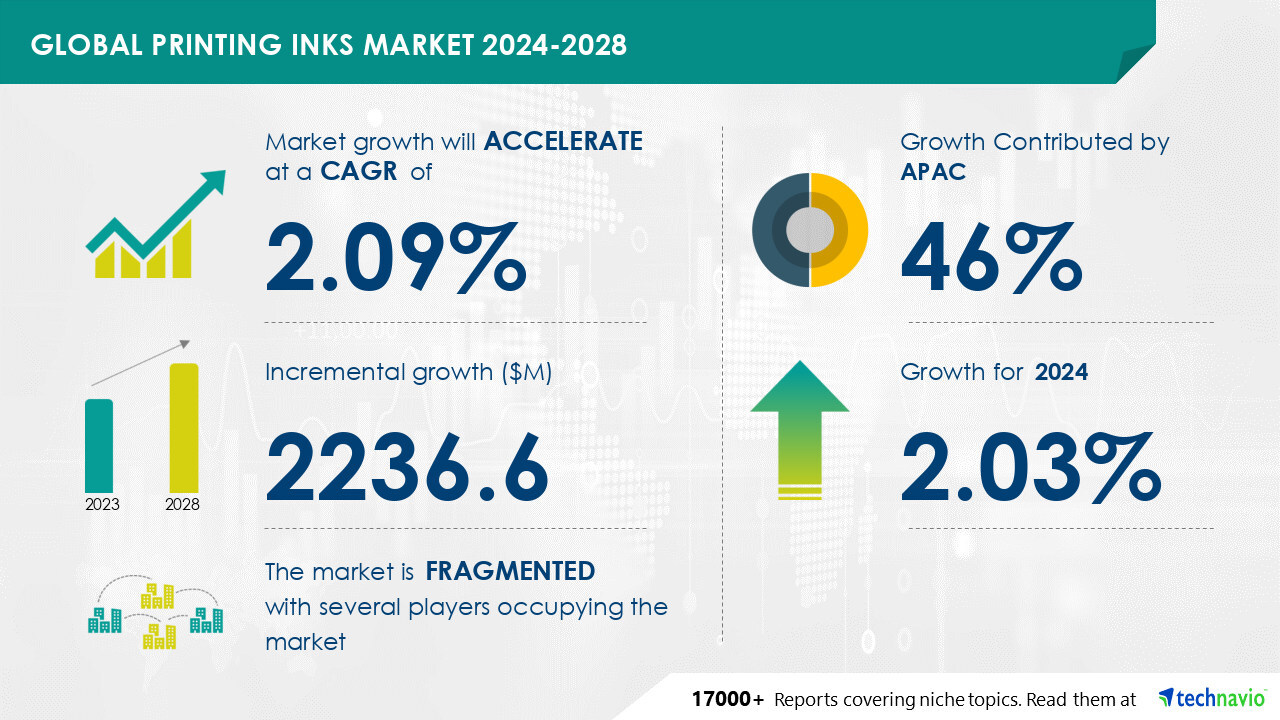NEW YORK , Aug. 27, 2024 /PRNewswire/ -- Report with market evolution powered by AI- The global printing inks market size is estimated to grow by USD 2.23 billion from 2024-2028, according to Technavio.
The market is estimated to grow at a CAGR of almost 2.09% during the forecast period. High demand for printing inks from packaging industry is driving market growth, with a trend towards new product development.

However, fluctuating crude oil prices poses a challenge. Key market players include Altana AG, Bordeaux Digital PrintInk Ltd., Dainichiseika Color and Chemicals Mfg.
Co. Ltd., DEERS i Co.
Ltd., DIC Corp., Dow Chemical Co.
, Encres DUBUIT, Epple Druckfarben AG, Flint Group, FUJIFILM Corp., MHM Holding GmbH, Sakata Inx India Pvt Ltd., SICPA HOLDING SA, Siegwerk Druckfarben AG and Co.
KGaA, Sun Chemical Corp., T and K TOKA Corp., Tokyo Printing Ink Mfg Co.
Ltd., Toyo Ink SC Holdings Co. Ltd.
, Vibrantz, and Zeller and Gmelin GmbH and Co. KG..
Get a detailed analysis on regions, market segments, customer landscape, and companies- View the snapshot of this report Market Driver In the global printing ink market, new product development is a significant trend, with manufacturers continually introducing new offerings to meet evolving customer needs. One prominent area of focus is the production of environmentally friendly inks, formulated from renewable resources and free of volatile organic compounds (VOCs) and other harmful chemicals. Another trend is the development of high-performance inks, which provide superior print quality and durability, as well as resistance to fading and scratching.
For instance, BASF has launched a new range of water-based printing inks derived from renewable resources and free of VOCs. Similarly, DIC has introduced a new line of high-performance offset inks designed for commercial printing applications, offering excellent print quality and durability. Flint Group has also developed a range of specialty inks for digital printing, suitable for various digital presses and delivering high-quality prints on diverse substrates.
These new product innovations will fuel the expansion of the global printing inks market over the forecast period. The Printing Inks Market is experiencing significant trends, with UV LED inks gaining popularity among ink manufacturers. These inks offer heat reduction, environmental friendliness, and versatility, making them ideal for various applications like membrane switches, graphics, and container & ad specialty items.
UV LED inks are also used in the production of textures and specialty clears. The global population growth and the expanding packaged foods industry are driving demand for UV LED inks in flexible packaging. Ink formulations are being developed using polyurethane, acrylic, lithographic solvents, polyamides, and gravure processes.
Middle-class populations in emerging nations and online retailing are also fueling market growth due to increasing internet penetration. Bio-degradable products and packaging labels are becoming more common, leading to the development of eco-friendly ink formulations. Pigments, binders, solubilizers, and additives are key ingredients in these formulations.
However, downward pricing pressure from inorganic solvents, toxic metals, and crude oil derivatives is a challenge for ink manufacturers. The Western market is a significant player, but growth is also expected from inorganic pigments and graphene-based inks. Explore a 360° Analysis of the Market: Unveil the Impact of AI.
For complete insights- Request Sample! Market Challenges The printing inks market is significantly impacted by fluctuations in crude oil prices due to the use of crude oil as a primary raw material. These price changes directly affect production costs, leading to increased ink prices for consumers and enterprises. Higher costs may result in lower profit margins for producers and distributors, prompting price wars and intense competition.
Volatility in crude oil prices can also disrupt the supply chain, potentially causing delays in manufacturing and distribution, and negatively impacting a company's ability to meet printing demands. To mitigate the impact of crude oil price fluctuations, printing ink companies employ hedging strategies such as forward contracts and raw material alternatives. However, these price changes pose a substantial challenge to market growth, affecting production costs, pricing strategies, profitability, and supply chain stability.
Companies must closely monitor and manage their exposure to crude oil price fluctuations to remain competitive and explore sustainable alternatives. The Printing Inks Market faces challenges in various sectors such as flexible packaging, commercial printing & publishing, and packaging labels. Pigments, binders, solubilizers, and additives are key ingredients, but there's downward pricing pressure due to inorganic solvents and toxic metals.
Crude oil derivatives and inorganic pigments are under scrutiny due to environmental concerns. New technologies like graphene, carbon, and modified cellulose offer solutions. Ink-jet products and printing inks for publications (newspapers, magazines) face digitalization.
Urbanization drives demand for packaging materials, especially in the snacks & confectionery category. Production technologies and packaging practices like case-ready packaging, energy-curing inks (UV-cured, solvent-UV hybrid), latex (resin) inks, and solid inks impact the market. Volatility in VOC, bonding qualities, drying time, productivity, and high performance are crucial factors.
Flint Group and other players navigate these challenges while balancing environmental benefits, energy costs, and customer needs. For more insights on driver and challenges - Request a sample report! Segment Overview This printing inks market report extensively covers market segmentation by 1.1 Lithographic inks 1.
2 Gravure inks 1.3 Flexographic inks 1.4 Digital inks 1.
5 Others 2.1 Packaging and labeling 2.2 Publication and commercial printing 2.
3 Corrugated cardboards 2.4 Others 3.1 North America 3.
2 Europe 3.3 APAC 3.4 Middle East and Africa 3.
5 South America 1.1 Lithographic inks- The global printing inks market is significant, with the lithographic inks segment holding a substantial share. Lithography printing, a widely used technique for high-quality printing in various applications like packaging, commercial printing, publishing, and more, necessitates specialized lithographic inks.
These inks are produced using pigments, resins, solvents, and additives to adhere effectively to the printing surface. Their vibrant colors, excellent print quality, and brightness make lithographic inks suitable for diverse printing needs. The packaging sector's expansion, especially in emerging economies, fuels the growth of the lithographic inks segment.
The increasing demand for visually appealing packaging and labels necessitates the use of high-quality inks. Additionally, the commercial printing industry, which includes printing for promotional materials, advertisements, and related uses, also influences the demand for lithographic inks. North America and Europe , with established printing industries, are major markets for lithographic inks.
However, Asia Pacific , driven by fast industrialization, urbanization, and rising consumer spending in countries like China and India , is experiencing significant growth in this sector. The packaging and commercial printing industries' capacity to produce superior-quality prints for various applications will propel the growth of the global printing inks market during the forecast period. For more information on market segmentation with geographical analysis including forecast (2024-2028) and historic data (2017-2021) - Download a Sample Report Research Analysis The Printing Inks Market encompasses a wide range of products used in various industries, including commercial printing and publishing, packaging labels, and publications such as newspapers and magazines.
The market is driven by urbanization and increasing consumer demands for high-quality printed materials. However, the market faces downward pricing pressure due to the proliferation of digitalized needs and ink-jet products. Pigments, binders, solubilizers, and additives are essential components of printing inks.
Inorganic solvents and toxic metals are being replaced by eco-friendly alternatives due to growing environmental concerns. The packaging sector, particularly food packaging, is a significant market for printing inks, with trends toward case-ready packaging and energy-curing inks like UV-cured inks gaining popularity. Production technologies and printing practices continue to evolve, with advancements in UV-cured inks and water-based inks leading the way.
The Western market is a major consumer of printing inks, but emerging economies are expected to drive growth in the coming years. Overall, the Printing Inks Market is a dynamic and evolving industry that is constantly adapting to changing consumer needs and technological advancements. Market Research Overview The Printing Inks Market encompasses a wide range of products used in various industries, including flexible packaging, commercial printing & publishing, and packaging labels.
The market is driven by urbanization, digitalized needs, and the increasing demand for packaging materials in sectors like food and snacks & confectionery. Inks are made up of pigments, binders, solubilizers, and additives, with formulations varying for different applications. Inks for flexible packaging have seen significant growth due to their versatility and energy savings through technologies like energy-curing inks (UV-cured, UV LED, and solvent-UV hybrid inks), solid inks, and latex (resin) inks.
However, downward pricing pressure and environmental concerns have led to the exploration of alternatives, such as graphene, carbon, and modified cellulose-based inks. Inorganic pigments, derived from crude oil, have faced scrutiny due to their toxicity and the use of inorganic solvents. In response, there is a shift towards organic pigments and solvents, as well as water-based and UV-curable inks.
The market also caters to various industries, including publications (newspapers, magazines), membrane switches, graphics, container & ad specialty, and textures, with each requiring unique ink formulations and properties such as high performance, bonding qualities, drying time, productivity, and environmental benefits. The Western market dominates the printing inks industry, but emerging nations and the middle-class population in these regions are driving growth. The global population's increasing demand for packaged foods and urbanization have contributed to the industry's expansion.
The packaging practices of case-ready packaging and energy-efficient production technologies further fuel market growth. The food sector is a significant consumer of printing inks, with packaging materials playing a crucial role in preserving and enhancing product appeal. UV LED inks, polyurethane, acrylic, lithographic solvents, and polyamides are popular choices for food packaging due to their energy savings, versatility, and environmental friendliness.
The shift towards online retailing and internet penetration has led to the growth of ink-jet products, which offer customization and on-demand production. The market is also seeing an increase in demand for bio-degradable products, which aligns with the growing environmental consciousness. Ink manufacturers are constantly innovating to meet the evolving demands of various industries, with a focus on reducing energy costs, heat reduction, and environmental friendliness.
UV LED inks, for instance, offer significant energy savings and are increasingly being adopted for various applications. In conclusion, the Printing Inks Market is a dynamic and diverse industry that caters to various sectors and applications, with a focus on innovation, sustainability, and cost-effectiveness. The market is expected to continue growing due to urbanization, digitalization, and the increasing demand for packaging materials.
Table of Contents: 1 Executive Summary 2 Market Landscape 3 Market Sizing 4 Historic Market Size 5 Five Forces Analysis 6 Market Segmentation Type Lithographic Inks Gravure Inks Flexographic Inks Digital Inks Others End-user Packaging And Labeling Publication And Commercial Printing Corrugated Cardboards Others Geography North America Europe APAC Middle East And Africa South America 7 Customer Landscape 8 Geographic Landscape 9 Drivers, Challenges, and Trends 10 Company Landscape 11 Company Analysis 12 Appendix About Technavio Technavio is a leading global technology research and advisory company. Their research and analysis focuses on emerging market trends and provides actionable insights to help businesses identify market opportunities and develop effective strategies to optimize their market positions. With over 500 specialized analysts, Technavio's report library consists of more than 17,000 reports and counting, covering 800 technologies, spanning across 50 countries.
Their client base consists of enterprises of all sizes, including more than 100 Fortune 500 companies. This growing client base relies on Technavio's comprehensive coverage, extensive research, and actionable market insights to identify opportunities in existing and potential markets and assess their competitive positions within changing market scenarios. Contacts Technavio Research Jesse Maida Media & Marketing Executive US: +1 844 364 1100 UK: +44 203 893 3200 Email: [email protected] Website: www.
technavio.com/ SOURCE Technavio.




















